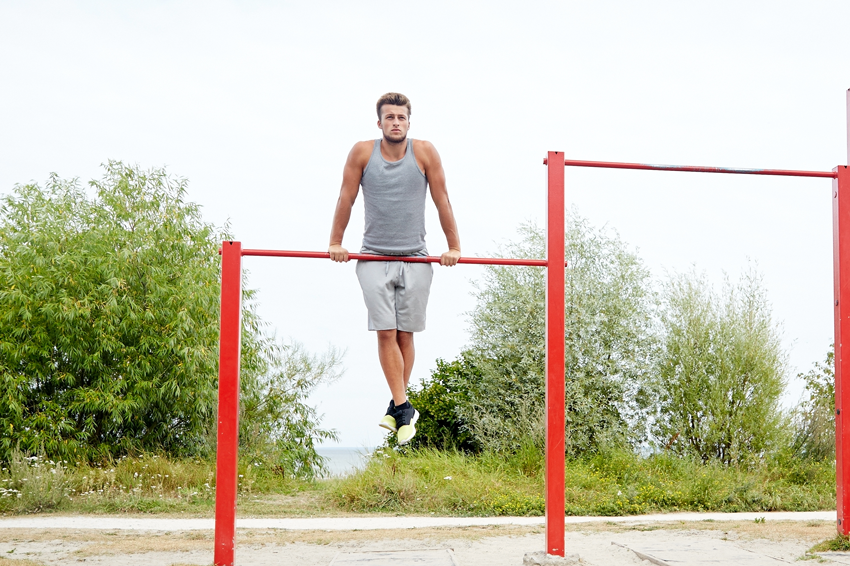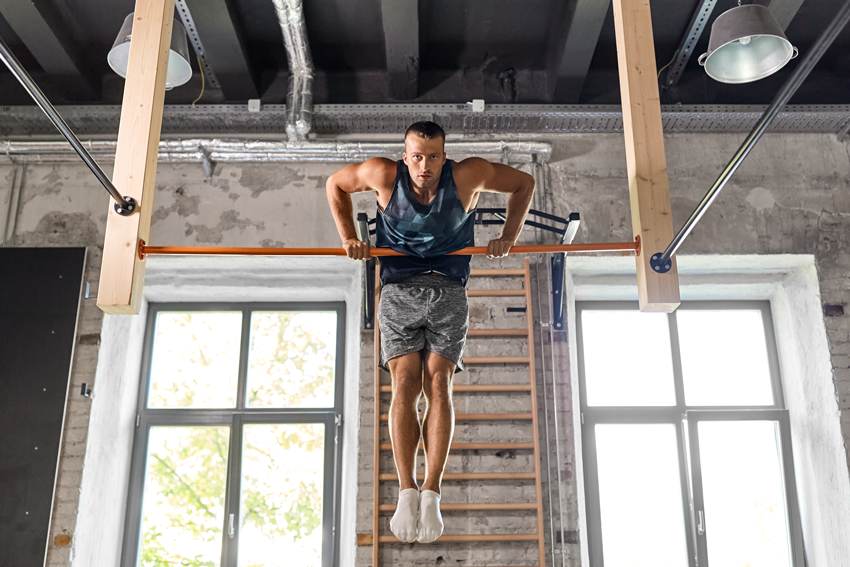Strength, explosive power and speed. These are the three skills you build when tackling the muscle-up. In order to do this visually impressive exercise, you first need to perfectly master pull-ups and straight bar dips, its two main movements. Read on to learn the secrets of the flawless muscle-up.
Some consider the muscle-up to be a pull-up variation. But in reality, the muscle-up is more like a specific sequence of two key strength training moves: the pull-up and the straight bar dip. The distinctive characteristic of this exercise is this mighty combo that strengthens your upper body. The muscle-up is divided into three phases: the pulling phase (where your body goes behind the bar), the transition phase (where your body rises above the bar) and the pushing phase (where you push your body up from the bar to finish with your arms straight).
MUSCLE-UP BENEFITS
Anyone who’s never done pull-ups or straight bar dips can give this exercise a miss. The muscle-up is a complex movement that demands solid strength training experience and extensive practice beforehand. Like a runner preparing for their first marathon, it’s best to follow a progressive training plan so that you can get through the main event easily and safely. But once you’ve practiced and mastered the muscle-up, you can quickly feel the benefits: more strength, explosive power, speed, core strength and stability when you do other strength training exercises or many other physical activities.
MUSCLES WORKED BY THE MUSCLE-UP
This exercise builds significant strength and muscle mass in your upper body. It fortifies your:
- Back muscles: lats, traps, teres major and teres minor. The pull-up you do is excellent for sculpting your back.
- Shoulder muscles: delts and rhomboids. This exercise constantly uses your shoulders, which is why it’s so important to make sure they’re properly warmed up first.
- Arm muscles: biceps and triceps. Your biceps are mobilized during the pull-up whereas your triceps take over when you push your body above the bar during the straight bar dip. Strong arms help control the movement and the speed (slow for the straight bar dip, fast for the swing as you transition from the pull-up to the straight bar dip).
- Chest muscles: pecs. These are used during the pushing phase as you move to the raised straight bar dip position.
- Forearm muscle: the brachioradialis. It’s used throughout the muscle-up, especially during the transition phase (between the pull-up and the straight bar dip).
- Abs muscles: transverse abdominis (deep muscle) and rectus abdominis. For the perfect posture during a muscle-up, your abs should be continuously engaged.
THE RIGHT MOVEMENT
The muscle-up is far from being a simple exercise. Using a flawless technique helps you avoid injuries especially to the muscles and joints in your shoulders and elbows, which are heavily used during this movement. Let’s break down the main steps of the muscle-up:
- Starting position: Stand about 20 in (50 cm) behind the bar to make it easier to swing your body and get above the bar. Keep your body engaged (abs tight, glutes and legs contracted) and your feet parallel.
- First phase: Grasp the pull-up bar with your elbows slightly bent to protect your elbow joints and place your hands on the bar wider than shoulder-width apart. Use a pronated grip (palms facing down) with your thumbs above the bar. This makes it easier to transition from the pulling phase to the pushing phase. Begin to hoist your body up by pulling on the bar, bringing your chin behind the bar followed by your chest.
- Second phase: To lift your body above the bar by transitioning from a pull-up to a straight bar dip, start by swinging your body. You can use knee raises to help you gain enough momentum to propel your body with speed and power above the bar.
- Third phase: Once your hips are level with the bar, move on to the pushing phase (the straight bar dip). Push on your arms until they’re straight, with your elbows parallel and locked to protect your joints. Control the movement as you come down from the bar, then repeat the exercise.
AVOID THESE COMMON MISTAKES
- Not learning the basics: Mastering the basics of this exercise requires a certain amount of strength. Knowing how to do flawless pull-ups and straight bar dips before attempting a full muscle-up is critical if you want to avoid injury. Think of learning pull-ups and straight bar dips as a prerequisite to the muscle-up. Once you’ve got these exercises down pat, you should be able to do at least 10-15 repetitions of each one. This ensures that you have the strength and power needed for muscle-ups.
- Not breathing regularly: Throughout the exercise, make sure you’re breathing steadily to establish a sufficient supply of oxygen and optimal muscle contraction. Inhale as you go up, and exhale as you come down.
- Neglecting your posture: To ensure the transfer of strength and stability during the exercise, your body has to stay engaged for the entire movement. Protect and keep your back straight by tightening your abs and make sure to contract your glutes and legs.
- Rushing through the exercise: Muscle-up training takes a lot of patience, perseverance. Go at your own pace. Conversely, going too fast puts serious stress on your muscles and increases your risk of injury. It may take you several weeks to achieve the perfect muscle-up and do several repetitions in a smooth set. But when you do, you’ll be even more proud of what you’ve accomplished!
- Not warming up: As with any workout, warming up is essential before your session. In the case of the muscle-up, it helps you prepare your joints and reduces the risk of injury. Post-workout recovery is equally important. Consider stretching and using a tennis ball or foam roller to massage the areas the muscle-up targets, such as your back and shoulders. This promotes muscle fiber healing and helps you better manage fatigue after intense training for the muscle-up.
EASIER ALTERNATIVES TO THE MUSCLE-UP
You can train to do the muscle-up using a resistance band attached to the bar. You can also start your training with alternative exercises that are more accessible for beginners.
- Pull-ups for strength: Beginners who want to build the strength needed for the muscle-up can try their hand at our program Beginner Pull-Ups. Learn how to achieve your first pull-ups in just three weeks.
- Burpees for explosive power: Gain explosive power and mobilize your entire body with the burpee, a full body strength training exercise. Challenge yourself with our nothing-but-burpees program!
- Core strengthening with a suspension trainer: Try using a suspension trainer for stability training and to significantly improve your core strength, one of the essential athletic skills needed for the muscle-up. Turn yourself into a suspension trainer pro after three weeks with the RX 70 program.
A complex and technical movement, the muscle-up is an exercise that combines the strength of pull-ups and straight bar dips with speed and explosive power. Progressive training and patience are the keys to achieving your first muscle-up. Start our Muscle-Up program series to get the guidance you need and step up to the challenge!


